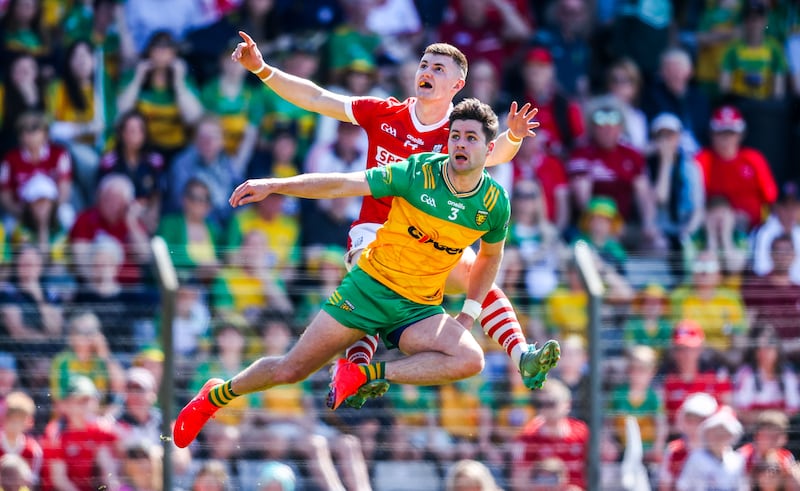John Considine tells a story about two All-Ireland hurling finals, one in 2018, between Limerick and Galway, and the other last year, Limerick’s latest title won by defeating Kilkenny.
“At the 2018 All-Ireland final I was there with a colleague. He was convinced that Joe Canning would score the free [for Galway]. I wasn’t, and moved to the aisle when he was about to take it. As soon as it dropped short, I was gone, walking out of the stand. I got back to the car and headed south and not a single Limerick car passed me.
“Last year, I was at the final with a different person and I said that I’d be off. Straight out, down to the quays. The amount of Limerick people who were out before me was phenomenal! I said they’ve had enough.
“Dublin used to drive attendances in the football but that’s not happening any more, either.”
Declan Hannon hands over the Limerick armband at `the right time’
McIlroy and Lowry both serious contenders as Masters gets underway
Ethan Rafferty considered walking away from intercounty football after goalkeeper rule change
Westmeath’s Ronan Wallace: ‘Even in the games we were behind in, we always kept fighting’
That’s an understatement. Far more impactful than the curious obsession over the attendance of 75 at the Tailteann Cup match between Longford and Waterford has been the collapse in attendances at Dublin’s matches in the Leinster championship and the home All-Ireland fixture against Roscommon.
There has been an apparent policy in Croke Park of trying to obscure embarrassing attendances by not releasing the figures on the day of the match. But the crowds at the Leinster final against Louth – 23,113 – and the Roscommon match – 11,176 – are pitiful and not at all appropriate for Croke Park.
The fall-off in Dublin’s drawing power has been detectable for six years. After decades of pulling 80,000 to all of their All-Ireland semi-finals, the number slipped to 54,716 against Galway in 2018. And although attendances have recovered, albeit with slight reductions – eg the Kerry semi-final in 2022 didn’t make capacity – the trend is down.
Dr Considine of UCC, who is a specialist in sports economics as well as an All-Ireland hurling medallist and an experienced coach, has had an interest in tracking attendances at GAA matches in recent years.
During the Covid years of 2020 and 2021, he expressed concerns that people getting out of the habit of attending matches might cause issues for the GAA when everything returned to normal.
“The evidence on people who attend games, studies show, is that those who were brought to matches by their parents when they were younger tend to be those who attend later. There’s a follow-through. Break that chain for maybe two or three years, that’s a whole cohort that hasn’t acquired that identifiable experience of going to games.
“That includes enjoying the spin, enjoying the stop-off coming back for a bag of chips.
“Things like this do have an impact beyond the obvious. Diarmuid O’Donovan, who was county administrator in Cork and worked with the Echo prior to that, was telling me that the GAA made its biggest inroads into the city over 100 years ago when soccer was in abeyance with people fighting in the first World War.
“The GAA made progress at that time, which was never really reversed.”

Asked to comment on the current situation, Considine said: “I cannot see attendances going back to near anything like they were, pre-Covid. You can get a bounce for certain things. We saw it with the new stadium 20 years ago or occasionally a new team coming through but we’re not going back to those days.”
The idea that people got out of the habit of attending matches during Covid may seem fanciful to some but there have been added impacts. Part of the GAA’s big marketing push that “nothing beats being there” has been under pressure in the past three years.
Institutions from universities to companies have been dealing with a reluctance on the part of students and employees to turn up and congregate in colleges and offices.
Similarly, there are presumably people who prefer to forego the inconvenience of travel – especially as there is so much of it to be done during the football championship and with unprecedented availability on broadcast and streaming, processes they became accustomed to during Covid.
There has been an added influence on the years since then, the introduction of a new championship format, which tries to combine the merits of league and knock-out – the latter for the excitement it creates and the former for the revenue generated.
It looks like a structure that relies on a depth of competition that isn’t there, as the group matches and their attendances indicate. Then again, round-robin as a format was never terribly popular with the Gaelic games community until the Munster hurling championship struck oil in the past few years.
For now it is ultra-competitive and draws big crowds in a way its Leinster counterpart doesn’t really.
Then there is the question of inappropriately sized venues, such as Páirc Uí Rinn, which resembled a colosseum at the weekend with just 7,251 in attendance.
Considine is of the view that the GAA need to survey members to see what they would like in the match-going experience: better facilities, catering, prematch entertainment, etc.
As he points out, such a strategic approach can take into account the demographics committees in all counties to work out the spread of the games. Is there a case for more realistically sized venues? As he says, “do we need to put further resources into, say, Portlaoise because of the road network?”
While the GAA grapples with optimal formats for the football championship, the right number of matches – enough to engage sustainable interest but not so many that supporters lose interest for long spells of the season – there is serious work to be done in establishing how best to fit the championship into modern society.
















